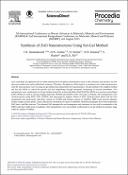Options
Synthesis of ZnO Nanostructures Using Sol-Gel Method
Journal
5th International Conference On Recent Advances In Materials, Minerals And Environment (Ramm) & 2nd International Postgraduate Conference On Materials, Mineral And Polymer (Mamip)
Date Issued
2016
Author(s)
Hasnidawani, JN
Azlina, HN
Norita, H
Bonnia, NN
Ratim, S
Ali, ES
DOI
10.1016/j.proche.2016.03.095
Abstract
Zinc oxide plays an important role in current industry due to its special characteristics such as anti-corrosion, anti-bacteria, has low electrons conductivity and excellent heat resistance. Therefore, the objective of this study is to synthesize zinc oxide nanostructures with the most practical ways by using sol-gel method and characterize the nanostructures. Sol-gel method is the simplest method and has the ability to control the particle size and morphology through systematic monitoring of reaction parameters. ZnO nanoparticles were synthesized via sol gel method using Zinc acetate dehydrate (Zn(CH3COO)(2)center dot 2H(2)O) as a precursor and ethanol (CH2COOH) was used as solvent, Sodium hydroxide ( NaOH) and distilled water were used as medium. ZnO nanoparticles were characterized by using XRD, EDX, FESEM, and nano-particles analyser. Result of EDX characterization shows that the ZnO nanoparticles has good purity with (Zinc content of- 55.38% and; Oxygen content of- 44.62%). XRD result spectrum displays mainly oxygen and zinc peaks, which indicate the crystallinity in nature as exhibited. FESEM micrographs shows that synthesized ZnO have a rod-like structure. The obtained ZnO nanoparticles are homogenous and consistent in size which corresponds to the XRD result that exhibit good crystallinity. ZnO nanoparticles were successfully synthesized by sol-gel method in nanosize range within 81.28nm to 84.98nm. (C) 2016 The Authors. Published by Elsevier B.V.
Subjects
File(s)
Loading...
Name
Synthesis of ZnO Nanostructures Using Sol-Gel Method.pdf
Size
343.09 KB
Format
Adobe PDF
Checksum
(MD5):159c0de7f3590cd284151493df66dafe